Most people don’t think about what happens with a customer after they’ve made a purchase – whether it’s offline or online. But for online store owners, thinking about post-purchase customer engagement shouldn’t be an afterthought or a missed opportunity. It should be a critical part of their strategy.
What Does Post-Purchase Customer Engagement Mean?
Post-purchase customer engagement is exactly what it sounds like – the engagement with a customer right after they’ve made a purchase. Unfortunately, for most online stores, their idea of post-purchase customer engagement is the automatic emailing of a receipt.
Post-purchase customer engagement is so critical, as Linnworks describes:.
Ultimately, optimizing and enhancing the post-purchase experience bridges the gap between the customer and the retailer. Creating a positive post-purchase experience is a great opportunity for merchants to develop strong relationships with their customers, build a loyal customer base and improve their lifetime value (LTV).
Why Is That Engagement So Critical?
Over the last two decades, I’ve built enterprise SaaS products. Over that time, if there was one lesson we all drilled into anyone and everyone’s head, it was this: it’s always easier to sell back to the base.
Once someone trusts you to solve one of their problems, you earn the right to solve another. But only if they know you can. This is why enterprise salespeople learn the “did you know we also…” technique. Because most of the time, clients don’t know all of what you can do.
This reality is true whether you’re selling products or services. And there’s no better time to educate a customer than after they’ve demonstrated they’re willing to trust you (with a purchase).
And it’s true whether you’re selling to an enterprise or to a consumer.
The marketing professionals at MainPath shared the metrics that matter. Existing clients are more likely (60%-70%) to buy your product or service than new clients (5%-20%), at lower costs (6-7 times less).
A LinkedIn article written by Colin Shaw noted that it costs a company 6-7 times more to acquire a new customer than to retain an existing one. The same article also mentions that, according to Marketing Metrics, the probability of selling a product or service to an existing client is in the neighborhood of 60%-70%, while the probability of selling to a new client is only 5-20%.
This is why the post-purchase moments and interactions are so critical. Building that trust, leveraging the relationship you’ve already started, helps bring your costs down and increases the overall lifetime value of a customer.
What Are Examples of Post-Purchase Customer Engagement?
Beyond the normal delivery of a receipt, we all know the benefits of sending a welcome email. But imagine getting that welcome email every time you make a purchase. It can start to break trust and feel disingenuous pretty quickly, right? After all, how many emails from the CEO do I need? And will I believe?
Here are four examples that aren’t very difficult to implement.
1. First Purchase Emails
So sending an email after a purchase, but only after a first purchase, and only to someone who purchased a product where they actually spent money (as in, no 100% coupon), would be a good idea.
And you can even, as you see in this example, prep them for the follow-up that you’ll schedule.
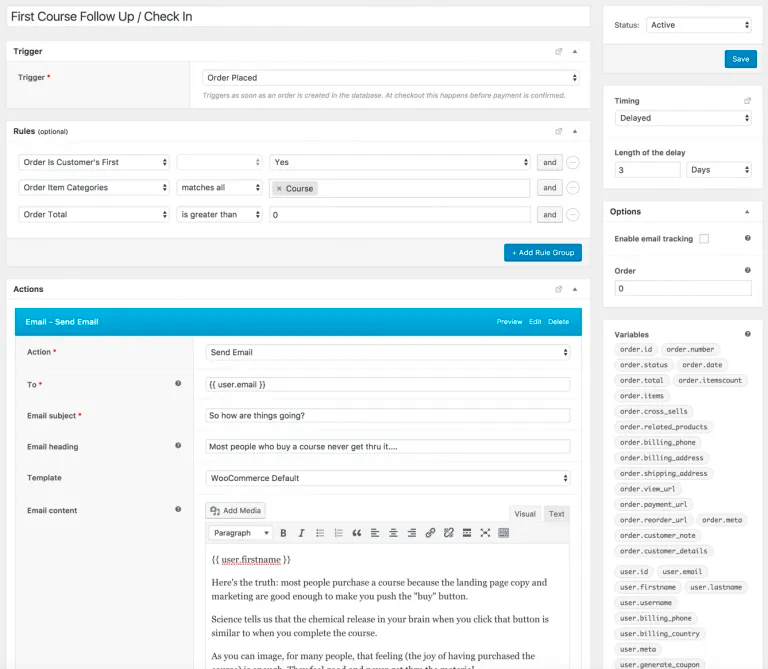
2. Follow-Up Emails on First Purchases
In this example, we’re following up and asking what questions they have. But let’s be clear – it’s only for the first-time buyers of an online course. So we can shape the message effectively – and we delay it by 10 days (from the purchase) so we know we’ve given them time to dig into the content.
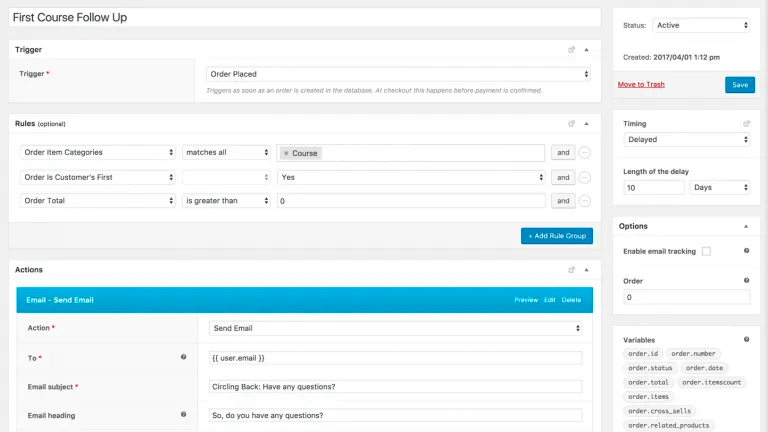
3. Special Deals for Special Products
One of the tricks I share with people who sell online courses or memberships is that it’s always more engaging if you can talk to someone else about the work you’re doing.
The logical approach here is to create an offer that allows a customer to invite a friend. And you can do that with a coupon code and a custom email.
Notice in this example that we’re also making sure that no coupon codes were used to make the initial purchase.
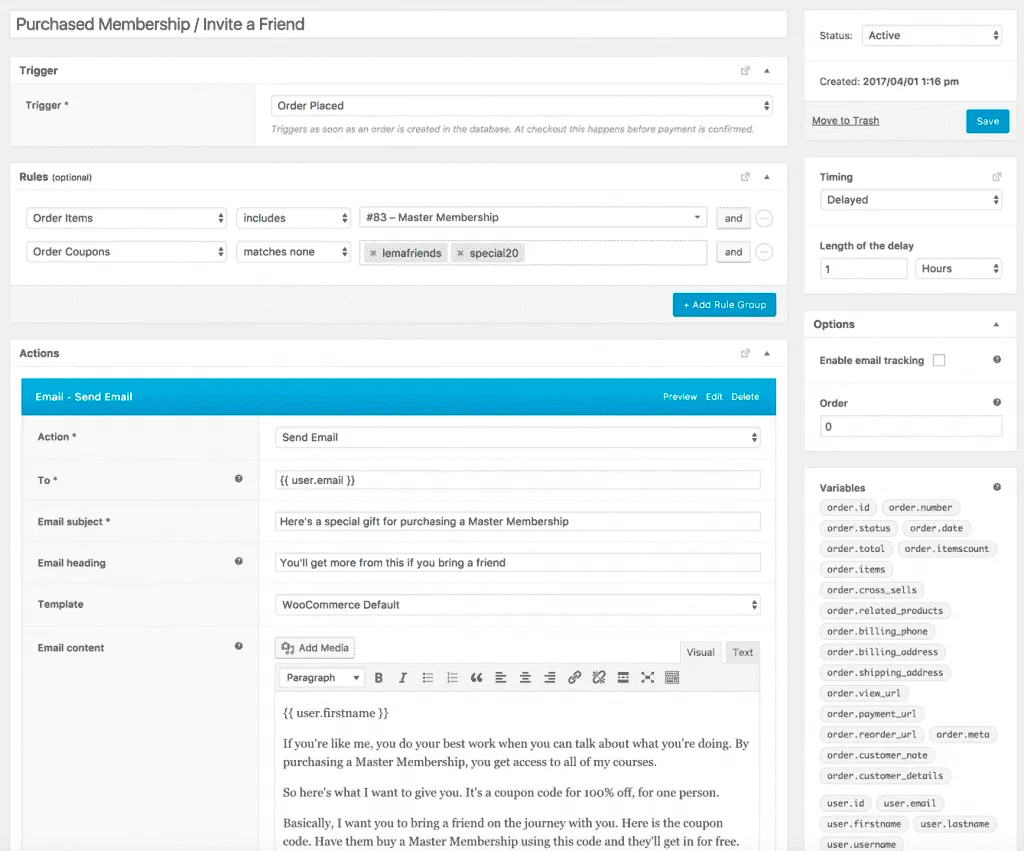
4. Bringing Back Old Customers
Another great example of post-purchase engagement is the email you might send to someone who has made a certain number of purchases in the past (in this case, four) and spent a certain amount of money with you (in this case, $500), and yet hasn’t made a purchase in the last six months.
What you see here is the ability to target those customers either with an email or with a coupon that was created just for them.
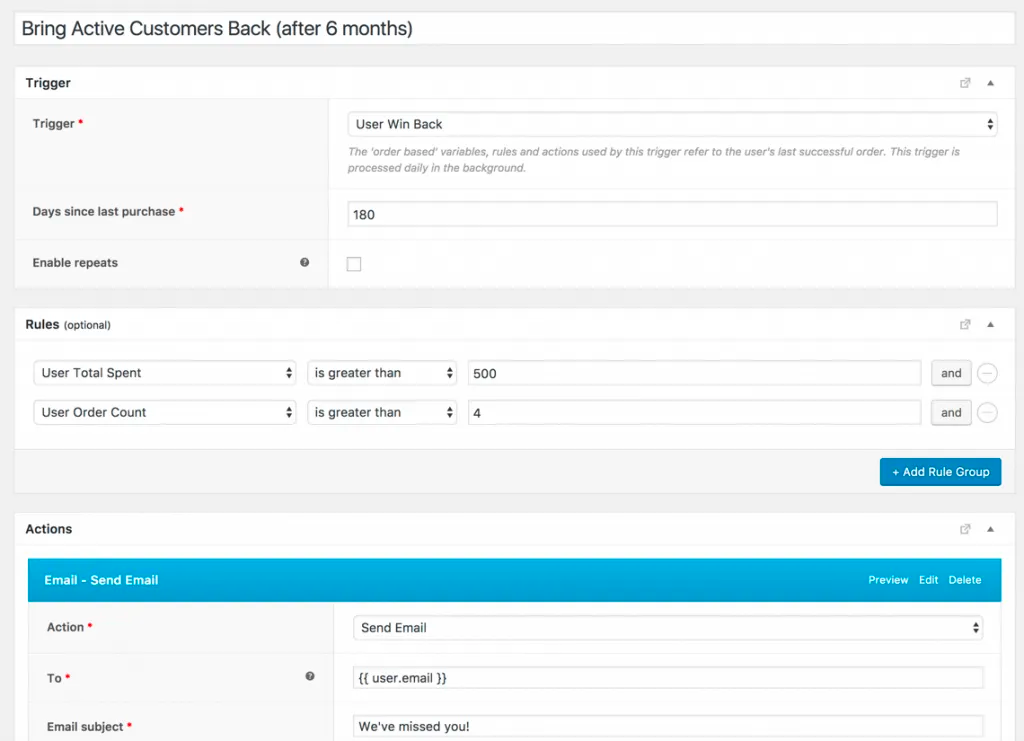
Don’t just take my word for it. Here are ideas from those same folks at MainPath:
“Email marketing software provider SilverPop mentions seven frequently used post-purchase email messages:
Service satisfaction survey – Ask your customers to complete a quick survey about their experience. This not only engages your customer but gives you valuable feedback about ways you can improve customer service even further.
Product/service review request – Similarly, you can ask your customer to provide a review of the product or service they received from you. Not only does this engage your customer and give you valuable feedback, but it also can be used to generate more interest and leads.
Review posted notification – If your customer provides a review, email them to let them know their review has been posted and provide a link. It can also be helpful to enable social sharing so they can spread the word if they choose.
Cross-sell/recommendation – Recommend a product or service related to what your customer has already purchased. Show them that you appreciate their purchase and are looking out for other ways to help them.
Replenish reminder/short-supply notice – Whether your product should be replenished on a regular basis or you offer a service that should occur routinely, help your customers out by sending them reminders. In heavily packed schedules of the modern day, this thoughtful engagement tactic will be appreciated.
Bounceback – Send a special offer or incentive to customers who have recently purchased something from you so that they’ll come back again soon.
Purchase anniversary – A purchase anniversary email acknowledges your customer in a personalized way and can include any of the above engagement tactics.
With each of these post-purchase messages, the basic strategy is to create additional touch points to keep customer engagement fresh while encouraging feedback and incentivizing future purchases.“
How Do You Automate Post-Purchase Engagement?
What you’ve seen in the examples above are not just notions of what you could do. The screenshots demonstrate an automated way of approaching the post-purchase engagement. This is done with triggers, rules, and workflows.
These examples are what people meant when predicting the power of marketing automation years ago — the stuff that your best salespeople used to do by hand, and now can be managed by software.
Think of marketing automation as email marketing on steroids. Gone are the days of a single, monthly newsletter promoting the same product to the same audience. Marketing Automation allows you to personalize your customer communications based on their behavior and profile.
To enable this marketing automation, you need three things:
- An ecommerce system (like WooCommerce)
- An automated marketing solution (like Mailchimp or AgileCRM)
- The integration between the two for triggering the rules & workflow
As an example, here is another rule that is based on first-time buyers. It takes a customer’s data and places a new record into my CRM solution (AgileCRM).
And if by some chance, they’re already in my system because of some purchase on a different site, this solution will update their record (in case I don’t have their shipping address, for example).
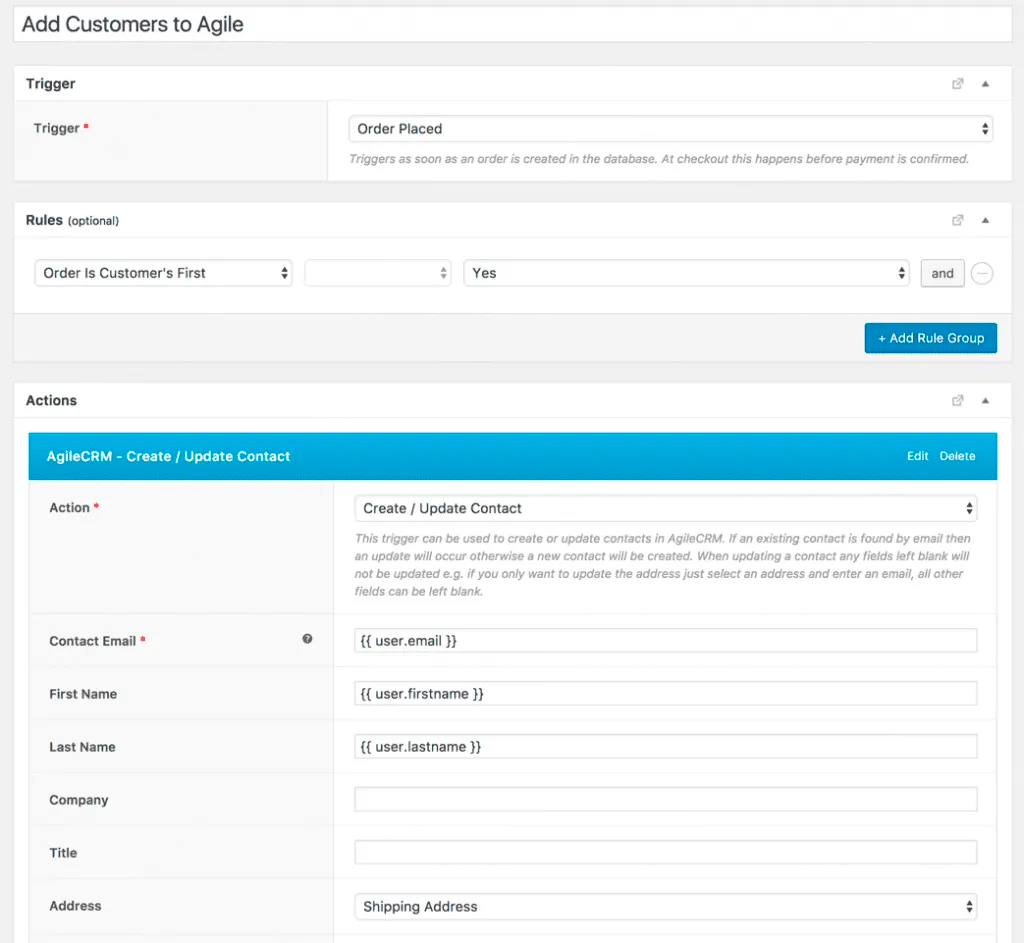
If You’re Using WooCommerce, Try AutomateWoo
If you’ve never heard of AutomateWoo, don’t worry. The good news is that it’s the glue you need to connect the dots between your ecommerce system if it’s WooCommerce and your CRM system.
They provide not only several triggers, rules, and workflows but also let you create your own, if you’re so inclined.
Check out the list of workflows they support.

That’s not a small list.
Having configured several of these workflows, I can assure you that the automation of your post-purchase customer engagement is only limited by your imagination, not the technology.
AutomateWoo is an excellent solution, at a price so low ($99) that you’d be hard-pressed to find a better way to spend the money. After all, it’s 6 to 7 times easier to sell to an existing customer than a new one. And that’s what AutomateWoo does for WooCommerce stores.
Get Started With Managed WooCommerce Hosting
Improve your customers' experience and increase sales by improving your online store's load times and security.
Try WooCommerce Managed hosting from Nexcess. Sign up today to benefit from increased speed, security, and scalability.

